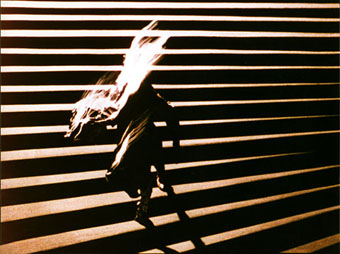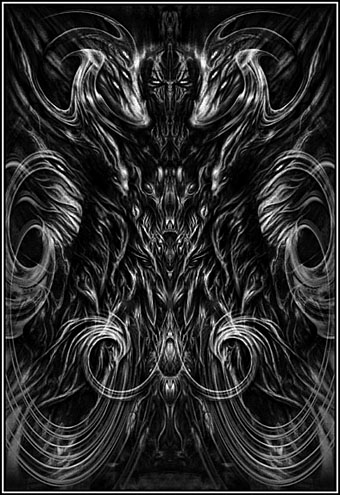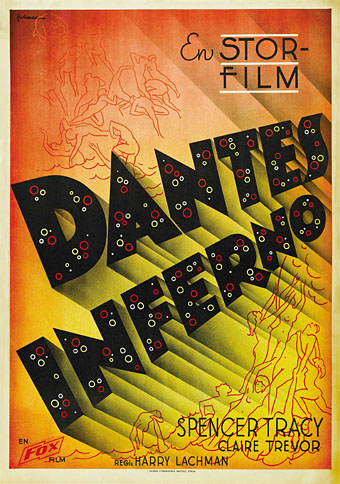Dogged by rumour: The riddles of Oz | Andrew Johnson and David Randall sift the truth from the lies surrounding the most watched film ever.
Category: {film}
Film
Patrick Bokanowski again
“A prolonged, dense and visually visceral experience of the kind that is rare in cinema today. Difficult to define and locate, its strangeness is quite unique. That its elements are not constructed in a traditional way should not be a barrier to those who wish to cross the bridge to what Jean-Luc Godard proposed as the real story of the cinema—real in the sense of being made of images and sounds rather than texts and illustrations.”—Keith Griffiths
It was only two months ago that I enthused about Patrick Bokanowski’s extraordinary 1982 film, L’Ange, after a TV screening was posted at Ubuweb, and ended by wondering whether a DVD copy was available anywhere. Last week Jayne Pilling left a comment on that post alerting me to the film’s availability via the BAA site; I immediately ordered a copy which arrived the next day. So yes, Bokanowski’s film is now available in both PAL and NTSC formats, and the disc includes a short about the making of L’Ange as well as preparatory sketches and an interview with composer Michèle Bokanowski whose score goes a long way to giving the film its unique atmosphere. I mentioned earlier how reminiscent Bokanowski’s film was of later works by the Brothers Quay so it’s no surprise seeing an approving quote from the pair on the DVD packaging:
“Magisterial images seething in the amber of transcendent soundscapes. Drink in these films through eyes and ears.”
If that wasn’t enough, there’s another DVD of the director’s short films available. Anyone who likes David Lynch’s The Grandmother or Eraserhead, or the Quays’ Street of Crocodiles, really needs to see L’Ange.
Previously on { feuilleton }
• L’Ange by Patrick Bokanowski
• The Hourglass Sanatorium by Wojciech Has
• Babobilicons by Daina Krumins
• Impressions de la Haute Mongolie revisited
• Short films by Walerian Borowczyk
• The Brothers Quay on DVD
Dream and Delirium
Dream and Delirium | Werner Herzog’s Fitzcarraldo diaries reviewed.
New things for July
In Spaces Between from The Great Old Ones (1999).
Some noteworthy pieces of news as the month draws to a rain-sodden and dismal conclusion.
• Frank Woodward was in touch this week to let me know that his excellent HP Lovecraft documentary, Lovecraft: Fear of the Unknown, will at last be appearing on DVD in October. This is a feature-length appraisal of Lovecraft’s life, work and influence, and includes contributions from Neil Gaiman, John Carpenter, Guillermo Del Toro, Caitlin R Kiernan, Peter Straub, Ramsey Campbell and Lovecraft scholar ST Joshi. A number of my artworks are included throughout and they’ll probably also be featured in a gallery section on the disc. The film was shot in HD so it’s being released on Blu-ray as well as regular DVD.
• Also Lovecraft-related, and also due out shortly, is DM Mitchell’s follow-up to the landmark Starry Wisdom anthology of Lovecraft-inspired texts and graphics. That volume was acclaimed in some quarters and condemned in others; I don’t doubt that this new work, Songs of the Black Wurm Gism, will manage the same. Contributors include David Britton, Grant Morrison and yours truly. The cover is Alan Moore’s splendid portrait of Asmodeus.
• Last but not least, Paul Schütze was also in touch this week with news that two more audio works have been added to his online catalogue. Soundworks 01 is his atmospherics created with with Andrew Hulme from the recent TV drama series Red Riding, while Tokyo/Osaka Live is two pieces of improvisation with Simon Hopkins. Both releases are available through iTunes.
Harry Lachman’s Inferno
Looking at Willy Pogány’s work last week I was reminded that as well as illustrating books he worked in Hollywood for a while as an art director and set designer. Among those jobs was a credit for “Technical staff” on the only film for which director Harry Lachman is remembered today, a curious 1935 melodrama, Dante’s Inferno. This stars Spencer Tracy as a fairground barker whose talent for drawing an audience helps an old showman boost the attendance at his moralising “Dante’s Inferno” attraction.
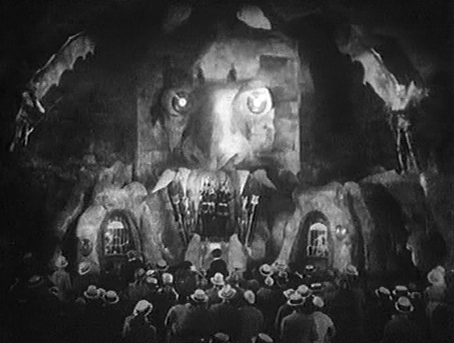
Entrance to the fairground attraction.
A hubristic rise and fall follows for Tracy, and the film spends much of its running time in routine business and family scenes. What sets it apart is some striking fairground designs (no doubt Pogány’s involvement) and a truly startling self-contained sequence when the old showman describes for Tracy the true nature of the Inferno. This sequence takes Gustave Doré’s celebrated illustrations and brings them to life in a series of atmospheric tableaux which even manage to contain brief glimpses of nudity. Hell, it seems, is the one place you can get away with not wearing any clothes. I’ve read many times that this sequence was borrowed from an earlier silent film, also called Dante’s Inferno, but have yet to come across any definite confirmation. It’s certainly possible since studios at that time treated other films in a very cavalier fashion; when a film was remade the studio would try to buy up and destroy prints of the earlier film. If anyone can point to more information about the origin of the Hell sequence, please leave a comment.
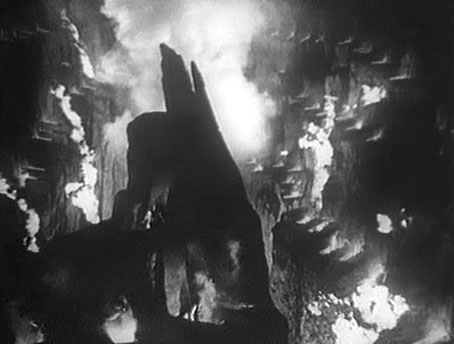
Stone tombs from the Inferno sequence.
If the Inferno sequence wasn’t already stolen in 1935, it works so well that it’s been plundered many times since; Kenneth Anger borrowed shots which he mixed into Inauguration of the Pleasure Dome (1954), Derek Jarman did the same for TG: Psychick Rally in Heaven (1981), and Ken Russell slipped some tinted scenes into Altered States (1980). I tinted the entire sequence red and dumped it into the one-off video accompaniment I made for Alan Moore and Tim Perkins’ stage performance of Angel Passage in 2001; it wouldn’t surprise me if it’s been used elsewhere. As with many of Hollywood’s products, Lachman’s film pretends to condemn prurience—Tracy’s character exploits Hell’s lurid attractions for gain—while revelling in the opportunity to show as much bare flesh as the censors would allow. As with Doré, Lachman’s Inferno seems populated solely by men and women in the peak of physical fitness.
Inevitably, you can see the Inferno sequence on YouTube here and here. The film doesn’t seem to be available on DVD but it’s worth seeking out to watch in full. In addition to the infernal delights, you also get to see 16-year-old Rita Hayworth’s screen debut as a dancer on a cruise ship.
Previously on { feuilleton }
• Willy Pogány’s Lohengrin
• Willy Pogány’s Parsifal
• Maps of the Inferno
• A TV Dante by Tom Phillips and Peter Greenaway
• The art of Lucio Bubacco
• The last circle of the Inferno
• Angels 4: Fallen angels

